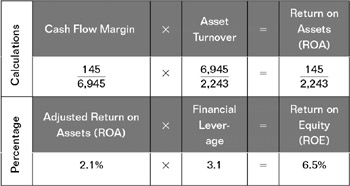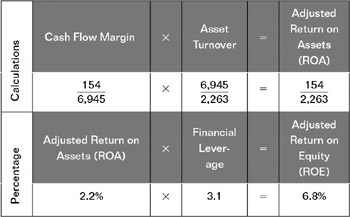A Comprehensive Example
|
To illustrate how the DuPont Model is used, let's use the following hypothetical balance sheet and income statement figures from a company we will call Cobain Enterprises (Exhibit 7-7 and Exhibit 7-8, respectively).
Exhibit 7-7: Cobain Enterprises's balance sheet.
| Average 2004 | $ Millions | % to Sales |
|---|---|---|
| Accts. receivable | 140 | 2.0 |
| Inventory | 1,235 | 7.8 |
| Other current assets | 107 | 1.5 |
| Total current assets | 1,482 | 21.3 |
| Less current liabilities | (1,256) | 18.1 |
| Equals working capital | 226 | 3.3 |
| Net fixed assets | 2,017 | 29.0 |
| Total assets | 2,243 | 32.3 |
| LT liabilities | 1,266 | 18.2 |
| Preferred stock | 255 | 3.7 |
| Common equity | 722 | 10.3 |
| Total liabilities plus equity | 2,243 | 32.3 |
|
[*]Cash flow = net income + depreciation | ||
| Year Ended 12/31/2001 | $ Millions | % to Sales |
|---|---|---|
| Net Sales | 6,945 | 100.0% |
| Gross margin | 1,672 | 24.1% |
| Operating expenses | 1,460 | 21.0% |
| Operating profit | 212 | 3.1% |
| Depreciation and amortization | 40 | 0.6% |
| Interest | 65 | 0.9% |
| Other income | 8 | 0.1% |
| Income before tax | 155 | 2.2% |
| Income taxes | 50 | 0.7% |
| Net income | 105 | 1.5% |
| Depreciation and amortization | 40 | 0.6% |
| Cash flow[*] | 145 | 2.1% |
|
[*]Cash flow = net income + depreciation | ||
Exhibit 7-8: Cobain's Coffee Roasters income statement.

Let's work through an example of how a hypothetical SA will affect ROA using DuPont. Assume that Cobain is looking to implement a $25 million supply chain management technology. Assume the following changes to the financial statement (Exhibit 7-9).
Exhibit 7-9: Impact on the adjusted ROA.

-
Fixed assets will increase by $20 million for the acquisition of the software and hardware associated with the system. The depreciation and amortization is $5 million per year over a five-year life. Depreciation and amortization would reduce the value of the assets. Total assets would become $2,263 million (total assets of $2,243 million plus $25 million, less $5 million in amortization and depreciation).
-
Assume a cash flow improvement of $9 million (see Exhibit 10-3 in Chapter 10 for details). Remember that this is a model that measures short-term impacts, so we can include these costs, assuming that they may not be incurred in future periods.
Exhibit 7-9 shows an increase in adjusted ROA from 6.5 percent to 6.8 percent. After looking at the drivers of ROA (cash flow margin and asset turnover), the impact to ROA comes from a lift in the cash flow margin. Asset turnover offsets the cash flow margin increase as it declines from 4.5 sales to 4.4 sales ( meaning "times").
|
EAN: 2147483647
Pages: 117